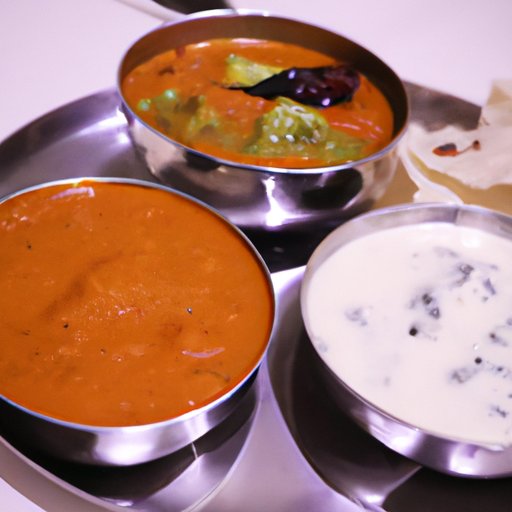
I. Introduction
For people with gluten intolerance, navigating Indian cuisine can be a minefield. Gluten is a protein found in wheat, barley, and rye, and it can cause serious health issues for some people. In this article, we’ll delve into the ins and outs of gluten-free Indian food and provide a handy guide for those on a gluten-free diet.
II. Is Indian Food Gluten-Free? A Comprehensive Analysis
Before diving into the specifics of gluten-free Indian food, it’s essential to understand what gluten is and where it’s commonly found. Gluten is a protein that gives bread, pasta, and baked goods their elasticity and structure. This protein is commonly found in wheat, but it can also be found in barley and rye.
Indian cuisine is known for using a variety of grains, including wheat, so it’s no surprise that many Indian dishes are not gluten-free. However, that doesn’t mean there aren’t any safe options for gluten-intolerant folks to enjoy. In this article, we’ll explore which Indian dishes typically contain gluten and which ones don’t.
III. The Definitive Guide to Gluten-Free Indian Food: Everything You Need to Know
If you’re on a gluten-free diet, it’s essential to know how to determine if a dish is safe to eat. Looking for certain ingredients, asking the chef/waitstaff, and researching ahead of time are essential steps. Some dishes and ingredients that are typically gluten-free in Indian cuisine include dal, chana masala, rice dishes, and tandoori dishes. However, cross-contamination can occur during preparation, so it’s always essential to ask the chef or waitstaff about any potential risks.
IV. No Wheat? No Problem! Navigating Gluten-Free Indian Food
For those who are new to gluten-free Indian cuisine, it can be challenging to navigate. Here are some tips for ordering gluten-free Indian food at restaurants or preparing it at home:
- Make sure to communicate with the chef or waitstaff about your dietary restrictions.
- Look for dishes that are naturally gluten-free, such as rice dishes, vegetable curries, and lentil dishes.
- If you’re preparing food at home, use gluten-free substitutes for wheat flour, such as rice flour, almond flour, or chickpea flour.
Some other challenges that may arise when trying to eat gluten-free Indian food include language barriers and cultural considerations. It’s essential to do your research and communicate clearly with the restaurant staff to avoid any misunderstandings.
V. Gluten-Free Indian Cuisine: Options, Tips, and Recipes
Ready to explore the world of gluten-free Indian cuisine? Here are some options to consider:
Commonly Gluten-Free Indian Dishes:
- Dal: a lentil soup
- Chana Masala: a chickpea curry
- Saag Paneer: a spinach and cheese dish
- Tandoori Chicken: grilled chicken marinated in yogurt and spices
Tips for Making Gluten-Free Indian Food:
- Use gluten-free substitutes for wheat flour (such as almond flour or chickpea flour) when making bread or other baked goods.
- Make sure to use gluten-free soy sauce or tamari in any recipes that call for soy sauce.
- Discover new ingredients such as gram flour and buckwheat flour that are naturally gluten-free.
Gluten-Free Indian Recipes:
- Chana Masala
- Palak Paneer
- Chicken Tikka Masala
VI. How to Enjoy Authentic Indian Cuisine When You’re Gluten-Free
For those who are gluten-free, finding and researching gluten-free Indian restaurants in your area is essential. It’s also important to communicate with restaurant staff about your dietary needs and any potential risks involved.
Cultural considerations should also be taken into account. For example, beef is not traditionally consumed in Indian cuisine due to religious taboos, but chicken and lamb are often used instead.
VII. An Introductory Guide to Gluten-Free Indian Dishes
| Dish | Description |
|---|---|
| Tandoori Chicken | Grilled chicken marinated in yogurt and spices. |
| Palak Paneer | A dish made with spinach and paneer cheese. |
| Chana Masala | A popular chickpea curry dish. |
| Dal | A lentil soup that is commonly served with rice. |
VIII. Gluten-Free Indian Food Choices: A Quick Guide
By now, you’re well-equipped to navigate the world of gluten-free Indian food. Here are some of the need-to-know tips:
- Learn how to determine if a dish is gluten-free.
- Look for traditionally gluten-free Indian dishes, such as dal, chana masala, and tandoori chicken.
- Communicate clearly with restaurant staff, and research your options ahead of time.
With these tips in mind, you’ll be able to enjoy authentic Indian cuisine without compromising your dietary needs.
IX. Conclusion
We hope this comprehensive guide has been helpful in navigating the world of gluten-free Indian cuisine. With so many delicious options to choose from, it’s important to stay informed and learn how to communicate with restaurant staff. With practice, you’ll be able to enjoy authentic Indian cuisine without any worries.
Don’t forget, there are many resources available for those exploring gluten-free Indian cuisine, such as recipe books and apps. Try experimenting with new ingredients and dishes at home, or visit a local restaurant and discover something new.




